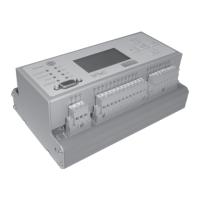19
BA 2076/02/01
7 Indication and Parameterization
PP
PP
P
arar
arar
ar
ameterizing the cooling-phase-specific windingameterizing the cooling-phase-specific winding
ameterizing the cooling-phase-specific windingameterizing the cooling-phase-specific winding
ameterizing the cooling-phase-specific winding
parpar
parpar
par
ameterameter
ameterameter
ameter
ss
ss
s
This menu item can be used to
parameterize all winding parameters of
the cooling stage <Cooling 0>.
Parameterization of the cooling stages
<Cooling 1> to <Cooling 4> is similar.
For more information on linking the winding parameters with
the switching contacts, see page 13 in chapter 5.6.
Rated CT currentRated CT current
Rated CT currentRated CT current
Rated CT current
The rated CT current is the value of the
CT output at the rated load of the
transformer. This can be set in this menu
item for every cooling stage between 0.5
and 5.0 A.
The rated CT current is calculated from the rated current of
the transformer (this may depend on which cooling stage is
active) divided by the ratio of the CT transformer.
Example: Rated current of transformer I
N
: 820A
CT ratio R: 1000 : 1
I
CT
= I
N
/ R = 820A / 1000 = 0.82A
GrGr
GrGr
Gr
adient (gr)adient (gr)
adient (gr)adient (gr)
adient (gr)
The gradient specifies the difference
between oil and winding temperature at
the rated load. If, for example, a gradient
of 26 K is set and the transformer is
operated at rated load, then the average
winding temperature (Hotspot factor 1,0) is 26 K higher than
the oil temperature. If the transformer has been off for some
time, the winding temperature is the same as the oil
temperature.
The value of the gradient may differ for the individual cooling
stages.
Winding exponent yWinding exponent y
Winding exponent yWinding exponent y
Winding exponent y
The winding exponent can be set within a
range of 1.0 to 2.0.
IEC 60354 specifies the following values
for different types of cooling.
Cooling ON… Y = 1.6
Cooling OF… Y = 1.6
Cooling OD… Y = 2.0
For calculations to ANSI standards, the value of y to be
applied, is the result of (2xm). According to ANSI standards,
the values for m range from 0,8 to 1,0.
Rated Current 0_
2,00 A__
Save ?
YES NO_
Gra
di
en
t(
gr)
0
26,
0 K
__
Sav
e ?
YES
NO
Winding Expo. 0_
1,6___
Save ?
YES NO_
Time Constant 0_
8 min
Save ?
YES NO_
Time constant Time constant
Time constant Time constant
Time constant
tt
tt
t
A sudden change of the load current does
not result in a sudden change of the
winding temperature. The winding
temperature approaches its actual final
value according to an e-function (please
refer to page 13 ). Due to a sudden rise of load current the
winding temperature will reach 63,5% of the peak value after
a duration of
tt
tt
t and 95% of the peak value after a duration of
3
t.t.
t.t.
t.
Since the time constant can be different for each cooling
stage, it can be set individually from 0.0 to 30.0 minutes for
each cooling stage.
7.37.3
7.37.3
7.3
Switching ContactsSwitching Contacts
Switching ContactsSwitching Contacts
Switching Contacts
This menu can be used to set and
configure the switching points S1 to S4,
ALARM and TRIP.
Load change intervalLoad change interval
Load change intervalLoad change interval
Load change interval
This menu item can be used to
parameterize the load change interval.
Setting the value to 0 here deactivates
the load change interval.
Menu for switching points S1 to S4, ALARM and TRIPMenu for switching points S1 to S4, ALARM and TRIP
Menu for switching points S1 to S4, ALARM and TRIPMenu for switching points S1 to S4, ALARM and TRIP
Menu for switching points S1 to S4, ALARM and TRIP
Switching points S1 to S4 are designed
for the control of fans, for example, or
pumps. The ALARM switching point
generates an alarm message and the TRIP
switching point is used to trip the
transformer.
Parameterization of the individual switching points is the same
except that the submenus <Description> and <Alternate> are
omitted for the two switching points ALARM and TRIP.
The menu item <Description> indicates the designation of the
switching point. This can only be entered via the visualization
software.
Configuring the switching pointConfiguring the switching point
Configuring the switching pointConfiguring the switching point
Configuring the switching point
Control of the switching points can be
configured in different ways.
· With <
Manual OnManual On
Manual OnManual On
Manual On>. The switching
contact is set to continuous operation.
This setting cannot be made for the
switching points ALARM and TRIP.
· With <
Oil-Temp.Oil-Temp.
Oil-Temp.Oil-Temp.
Oil-Temp.>. The switching contact is activated via
the oil temperature.
· With <
Winding-Temp.Winding-Temp.
Winding-Temp.Winding-Temp.
Winding-Temp.>. The switching contact is activated
via the winding temperature.
<-SWITCH-POINT->
Altern.-Interval
Contact S1
Contact S2
Contact S3
Contact S4
Contact ALARM
Contact Trip
Alt
er
n.
-I
nte
rv
al
10
0 h
Sav
e ?
YES
NO
Con
fi
gu
re
S1
Man
ua
l On
Oil
-T
em
p.
Win
di
ng
-T
emp
.
Sav
e ?
YES
NO
-Cooling 0-_
Rated Current_
Gradient(gr)
Winding Exponent
Time Constant_
-CONTACT S1-
Description
Configuration
Switch-Point
Hysteresis
Delay-Time
Alternate_

